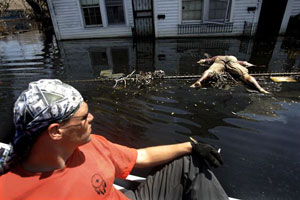 |
→ September 2005 Contents → Column
|
The Truth and Nothing But the Truth
|
 |
|||
|
Dead bodies in attics. Floating corpses. Crocodiles and rats mangling human remains. These are just some of the grisly sights, we are told, that Hurricane Katrina has left behind in Louisiana, Mississippi and Alabama. Now the Federal Emergency Management Agency has requested that journalists refrain from photographing these victims. Presumably, such photographs would be regarded as sensational and would violate standards of privacy and common decency.
Journalists have objected to the request on the grounds that it is impossible to convey the magnitude of the tragedy without these images and that FEMA's reluctance to take journalists on recovery expeditions is more about managing news coverage than it is about good taste. We believe journalists ought to make their own decisions about what to publish. We also believe that good taste may not be an overriding concern in stories like these. Concerns about human dignity must be balanced against the journalist's obligation to tell the story, as completely and accurately as possible.
The second assumption is this: Story details, including images, that appear to be sensational at first glance often are not. We believe there is a distinction between sensationalism as sensationalism and news that contains elements of sensationalism but that, taken as a whole, provides essential information that citizens need to confront if they are to engage in thoughtful moral decision-making. We offer a strategy at the end of this essay to help journalists make this distinction.
Most of us have a common-sense understanding of sensationalism. Historically, stories of accidents, fires, murders, violence, natural disasters and other sorts of mayhem have routinely been considered sensational - the type of news that one historian described as eliciting "unwholesome emotional responses" from readers. Critics accuse the journalists who tell these kinds of stories of pandering to the audience, and they often chastise the rest of us for paying attention. These stories are shallow and tasteless, and they edge out more important kinds of news.
On the other hand, these stories often depict threats to our moral or physical environments, and in those situations our interest might be justified. Stories that some dismiss as sensational can often reflect themes of good and evil, justice and injustice, and the unknown or unexpected. Clearly, these events and issues can be interpreted as challenges to our physical and/or moral well-being, and should command our attention.
In the past, such stories have played an important role in the development of our collective moral identity. Muckrakers in the early 1900s, for instance, used grim details when reporting stories about tenements, mental institutions and child labor. Their reporting called attention to pressing social problems that required the community's action. This type of story-telling is critical to the culture because it compels us to negotiate and renegotiate moral standards and boundaries. It forces us to ask and answer questions about our behavior toward fellow humans with whom we share our communities. These questions are fundamental to how we live our lives, and they shape who we are and who we want to become. So, it is a mistake to simply write off graphic stories or distasteful story details as unworthy of our attention. Sometimes telling a story in all of its horrible detail is appropriate, particularly if it forces us to confront issues related to social justice. To do otherwise disrespects the victims of social failures.
Because some of the news coverage that we routinely describe as sensational is necessary to the community's moral health, it is important to be able to distinguish between news that is sensational for its own sake and news that is sensational on its face but that contains critical information. Just how does the journalist make the distinction?
One way to answer the question is to consider the matter of intent. The journalist must be willing to honestly answer the following: "Why am I covering this story and covering it in this way?" The readers and viewers can make inferences about the journalist's motivation but the journalist is the only one who knows the answers. If the answers are "because I can," "because I want to impress my colleagues," "because the competition doesn't have the story," or "because it will get me noticed," then the story or some of its details may be considered sensationalism qua sensationalism, that is, sensational for its own sake. All these answers should raise red flags, and if they reflect the journalist's true intent, then audience criticism of the journalist and/or the journalist's press will be justified. Sensationalism for its own sake is manipulative and destructive. It is deceptive because it leads us to see our fellow humans as meaner, colder and less caring than they really are.
However, if the story or the details serve to illuminate a serious problem that warrants the community's attention, then the coverage is justified, even though the story details are violent or grotesque. For instance, if the grim tale is the result of a social policy that ought to be reconsidered, reporting the story is defensible, regardless what the critics say. Properly covered, elements or images that are normally associated with sensationalism but are central to the story can stimulate debate and lead to better social and political practices. That translates into better lives for all of us.
Ultimately, journalists, not government officials, must decide what information and what images to include in their stories. Honestly assessing their own motivations will help journalists make those judgments responsibly. That, in the end, should help all of us to make better decisions about how to live our lives, as individuals and as part of a larger community.
© Karen Slattery and Erik Ugland
|
||||
Back to September 2005 Contents
|
|
